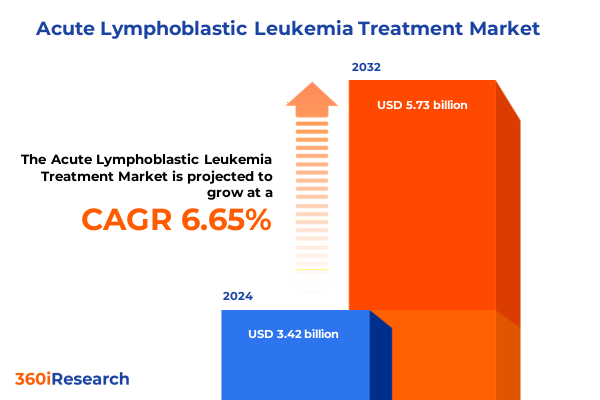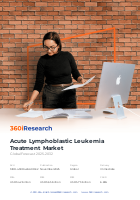The Acute Lymphoblastic Leukemia Treatment Market size was estimated at USD 3.42 billion in 2024 and expected to reach USD 3.65 billion in 2025, at a CAGR of 6.65% to reach USD 5.73 billion by 2032.

Unveiling the Emergence of Next Generation Approaches in Acute Lymphoblastic Leukemia Treatment That Redefine Therapeutic Paradigms and Patient Outcomes
Acute lymphoblastic leukemia represents one of the most aggressive hematologic malignancies, characterized by the rapid proliferation of immature lymphoid cells that compromise normal hematopoiesis. Historically, survival rates in adult and pediatric populations lagged behind other cancers, underscoring the urgency for more precise and potent treatment regimens. Over the past decade, advances in immunophenotyping and minimal residual disease monitoring have transformed diagnostic precision, enabling clinicians to stratify patients by risk and tailor induction and maintenance therapies accordingly.
In parallel, the emergence of targeted therapies has ushered in a new era of personalized medicine. Innovations such as bispecific T-cell engagers and chimeric antigen receptor T cell constructs are reshaping therapeutic paradigms by harnessing the patient’s own immune system to eradicate malignant clones. These groundbreaking modalities complement established cytotoxic agents, elevating complete remission rates and reducing relapse. As survival milestones extend and quality-of-life considerations gain prominence, the need for integrated care pathways that encompass novel biologics, supportive care, and digital health interventions becomes ever more critical.
Exploring the Revolutionary Shifts Transforming Acute Lymphoblastic Leukemia Care From Molecular Innovations to Holistic Patient Support Mechanisms
The landscape of acute lymphoblastic leukemia treatment is experiencing a wave of revolutionary shifts driven by molecular and immunologic breakthroughs. Precision diagnostics, leveraging next-generation sequencing and flow cytometry, now guide the deployment of targeted agents that inhibit key survival pathways within leukemic blasts. Concurrently, the clinical adoption of blinatumomab and inotuzumab has validated the potential of bispecific and antibody-drug conjugate therapies, offering new hope for refractory or relapsed cases.
Beyond molecular innovations, there is a growing emphasis on holistic patient support mechanisms. Digital health platforms facilitate remote monitoring of chemotherapy toxicities and adherence to oral regimens, while telemedicine has become integral to multidisciplinary consultations, particularly in underserved regions. Additionally, value-based care models are incentivizing coordinated interventions, from psychosocial counseling to fertility preservation, ensuring that therapeutic gains translate into meaningful long-term survivorship benefits.
Analyzing the Cumulative Effects of 2025 United States Tariffs on Acute Lymphoblastic Leukemia Treatment Inputs Manufacturing and Access Dynamics Nationwide
In 2025, the United States implemented a new schedule of tariffs that has materially influenced the cost dynamics of critical raw materials and active pharmaceutical ingredients used in acute lymphoblastic leukemia treatments. Key precursors for corticosteroids and vinca alkaloids, historically sourced from international suppliers, have seen import duties rise by up to 15 percent, exerting upward pressure on production expenses. Manufacturers are responding by reconfiguring supply chains and exploring domestic sourcing alternatives to mitigate margin compression.
These tariff-driven cost increases are reverberating through contract negotiations between hospitals, specialty pharmacies, and payers. Procurement teams face heightened scrutiny of formulary additions, leading to more rigorous value assessments of novel therapies such as L‐asparaginase formulations and CAR T cell products. While biopharmaceutical companies absorb a portion of the increased costs through optimized logistics and scale efficiencies, the cumulative effect has prompted healthcare providers to reevaluate budget allocations and accelerate adoption of biosimilar corticosteroids and generic antimetabolites where clinically appropriate.
Uncovering Deep Insights Into Patient Demographics Treatment Modalities and Distribution Channels That Drive Tailored Therapeutic Strategies in Leukemia Care
A nuanced understanding of patient demographics and therapeutic modalities is central to optimizing treatment pathways for acute lymphoblastic leukemia. Intravenous administration remains predominant for induction and consolidation phases, yet a growing cohort of maintenance therapies now leverage oral formulations to minimize inpatient exposure. Within the broad spectrum of drug classes, anthracyclines, antimetabolites, corticosteroids, L-asparaginase, and vinca alkaloids compose the backbone of cytotoxic regimens, while immunotherapies including CAR T cell constructs and monoclonal antibodies are increasingly integrated into multidimensional protocols. Distribution channels are evolving accordingly; hospital pharmacies continue to dominate regimen initiation and dose verification, whereas online pharmacies and retail outlets support outpatient dispensation of oral and self‐administered injectables. Treatment types range from traditional chemotherapy to advanced immunotherapy and targeted therapy, complemented by stem cell transplantation for high-risk cohorts. Finally, patient age group segmentation underscores distinct clinical considerations: pediatric cases benefit from intensification protocols and survivorship programs, adult patients navigate combination regimens with comorbidity management, and geriatric oncology demands dose modifications and toxicity mitigation strategies to preserve quality of life.
This comprehensive research report categorizes the Acute Lymphoblastic Leukemia Treatment market into clearly defined segments, providing a detailed analysis of emerging trends and precise revenue forecasts to support strategic decision-making.
- Route Of Administration
- Drug Class
- Treatment Type
- Patient Age Group
- Distribution Channel
Diving Into Regional Nuances Across Americas EMEA and Asia Pacific to Reveal How Geopolitical and Healthcare Infrastructure Variations Shape Treatment Access
Regional variations in healthcare infrastructure, regulatory frameworks, and economic development shape acute lymphoblastic leukemia treatment access across the globe. In the Americas, clinical trial networks and academic consortia have accelerated the adoption of novel immunotherapies, supported by reimbursement pathways that favor breakthrough designations and expedited approvals. In Europe Middle East and Africa, disparities in facility capabilities and payer mix have led to heterogeneous adoption rates; centralized pathology services in Western Europe contrast with decentralized delivery models in emerging markets, where patient advocacy groups play a critical role in navigating authorization and affordability.
Asia Pacific presents a dynamic landscape where government-led innovation programs and local manufacturing initiatives are expanding access to both generic and proprietary therapies. Collaborative partnerships between multinational biotech firms and regional distributors have enhanced the availability of CAR T cell treatments in metropolitan centers, while telehealth solutions bridge care gaps in rural provinces. Across all regions, evolving tariff policies and trade agreements continue to influence supply chain strategies, underscoring the interconnectedness of global healthcare ecosystems.
This comprehensive research report examines key regions that drive the evolution of the Acute Lymphoblastic Leukemia Treatment market, offering deep insights into regional trends, growth factors, and industry developments that are influencing market performance.
- Americas
- Europe, Middle East & Africa
- Asia-Pacific
Profiling Leading Pharmaceutical Innovators Shaping Acute Lymphoblastic Leukemia Therapeutics Through Strategic Collaborations and Pipeline Advancements
Leading biopharmaceutical innovators are shaping the acute lymphoblastic leukemia treatment frontier through a blend of strategic partnerships, emerging pipeline candidates, and life cycle management of established therapies. Prominent companies have leveraged in-licensing agreements to expand their portfolios, integrating next-generation monoclonal antibodies and bispecific engagers to complement existing small molecule franchises. Concurrently, internal R&D investments have propelled the advancement of targeted constructs, notably CD19-directed CAR T cell therapies, through late-stage clinical evaluation and regulatory submissions.
Moreover, collaborations between biotech startups and contract development organizations have accelerated biologics manufacturing capabilities, enabling scalable production of complex immunotherapies. Established pharmaceutical players are also enhancing patient support programs, deploying digital platforms that link prescribers, payers, and patients to streamline prior authorization and adherence monitoring. These concerted efforts reflect a broader industry commitment to sustaining innovation while addressing affordability and access challenges.
This comprehensive research report delivers an in-depth overview of the principal market players in the Acute Lymphoblastic Leukemia Treatment market, evaluating their market share, strategic initiatives, and competitive positioning to illuminate the factors shaping the competitive landscape.
- Novartis AG
- Amgen Inc.
- Pfizer Inc.
- Gilead Sciences, Inc.
- Jazz Pharmaceuticals plc
- Takeda Pharmaceutical Company Limited
- Baxter International Inc.
- Bristol-Myers Squibb Company
- F. Hoffmann-La Roche Ltd
- Johnson & Johnson
- Sanofi S.A.
- AbbVie Inc.
- Laboratoires Servier SAS
- Teva Pharmaceutical Industries Ltd.
- Merck & Co., Inc.
- AstraZeneca PLC
- Eli Lilly and Company
- Sobi AB
- Daiichi Sankyo Company, Limited
- Pfizer Ireland Pharmaceuticals
Delivering Strategic Recommendations to Enhance Treatment Efficacy Foster Innovation and Strengthen Operational Resilience in Acute Leukemia Care
Healthcare stakeholders must adopt proactive strategies to navigate the shifting acute lymphoblastic leukemia treatment environment. First, diversification of supply chains through strategic sourcing agreements will mitigate exposure to tariff volatility and ensure uninterrupted access to critical therapeutic inputs. Second, investment in biosimilar and generic development partnerships can unlock cost savings while preserving clinical standards, alleviating budgetary pressures on hospitals and payers.
Third, fostering cross-sector collaboration-uniting academic centers, contract manufacturers, and patient advocacy groups-will accelerate clinical trial enrollment and broaden real-world evidence generation for innovative modalities. Fourth, integration of digital health infrastructures to enable remote toxicity monitoring, teleconsultations, and adherence tracking will enhance patient outcomes and operational efficiency. Finally, aligning value-based contracting models with performance metrics will incentivize therapeutic innovation while ensuring equitable access across diverse patient populations.
Outlining Research Methodology Integrating Primary Interviews Secondary Data Review and Qualitative and Quantitative Techniques for Comprehensive Insights
This analysis harnessed a robust methodology combining qualitative and quantitative research techniques to secure a comprehensive perspective on acute lymphoblastic leukemia treatment. Primary research included in-depth interviews with clinical oncologists, pharmacoeconomists, hospital procurement leads, and patient advocacy representatives to capture firsthand insights on therapeutic adoption, cost pressures, and access barriers. Secondary data review encompassed peer-reviewed literature, clinical trial registries, regulatory agency publications, and proprietary databases to validate therapeutic profiles and policy developments.
Data triangulation was achieved by cross-referencing interview findings with aggregated healthcare utilization statistics, pharmaceutical import/export records, and global trade policy announcements. Analytical rigor was maintained through thematic coding of qualitative inputs and statistical trend analyses of secondary datasets. This integrated approach ensured the generation of actionable insights grounded in both empirical evidence and stakeholder perspectives.
This section provides a structured overview of the report, outlining key chapters and topics covered for easy reference in our Acute Lymphoblastic Leukemia Treatment market comprehensive research report.
- Preface
- Research Methodology
- Executive Summary
- Market Overview
- Market Insights
- Cumulative Impact of United States Tariffs 2025
- Cumulative Impact of Artificial Intelligence 2025
- Acute Lymphoblastic Leukemia Treatment Market, by Route Of Administration
- Acute Lymphoblastic Leukemia Treatment Market, by Drug Class
- Acute Lymphoblastic Leukemia Treatment Market, by Treatment Type
- Acute Lymphoblastic Leukemia Treatment Market, by Patient Age Group
- Acute Lymphoblastic Leukemia Treatment Market, by Distribution Channel
- Acute Lymphoblastic Leukemia Treatment Market, by Region
- Acute Lymphoblastic Leukemia Treatment Market, by Group
- Acute Lymphoblastic Leukemia Treatment Market, by Country
- Competitive Landscape
- List of Figures [Total: 30]
- List of Tables [Total: 513 ]
Synthesizing Critical Insights into Acute Lymphoblastic Leukemia Treatment Trends Dynamics and Strategic Imperatives to Guide Healthcare Decision Making
The acute lymphoblastic leukemia treatment landscape is at an inflection point defined by therapeutic innovation, policy recalibration, and evolving patient expectations. Precision diagnostics paired with novel immunologic agents are delivering unprecedented remission rates, while the rise of digital health solutions is enhancing treatment adherence and quality of life. Nonetheless, cost pressures driven by recent tariff policies and supply chain complexities underscore the need for strategic resilience.
As industry stakeholders chart the path forward, balanced investments in biosimilars, collaborative R&D models, and value-based care frameworks will be critical. By integrating clinical excellence with operational agility and patient-centric service delivery, healthcare leaders can translate scientific breakthroughs into sustainable outcomes. The insights presented here offer a strategic blueprint for optimizing acute lymphoblastic leukemia treatment across diverse geographies and care settings.
Connect with Ketan Rohom to Access Deep Acute Lymphoblastic Leukemia Treatment Insights Customized for Your Needs and Unlock Exclusive Research Benefits
Contact Ketan Rohom to explore how this report can be tailored to your organization’s strategic objectives and secure prioritized access to comprehensive acute lymphoblastic leukemia treatment insights that drive informed decision-making and competitive advantage

- How big is the Acute Lymphoblastic Leukemia Treatment Market?
- What is the Acute Lymphoblastic Leukemia Treatment Market growth?
- When do I get the report?
- In what format does this report get delivered to me?
- How long has 360iResearch been around?
- What if I have a question about your reports?
- Can I share this report with my team?
- Can I use your research in my presentation?




